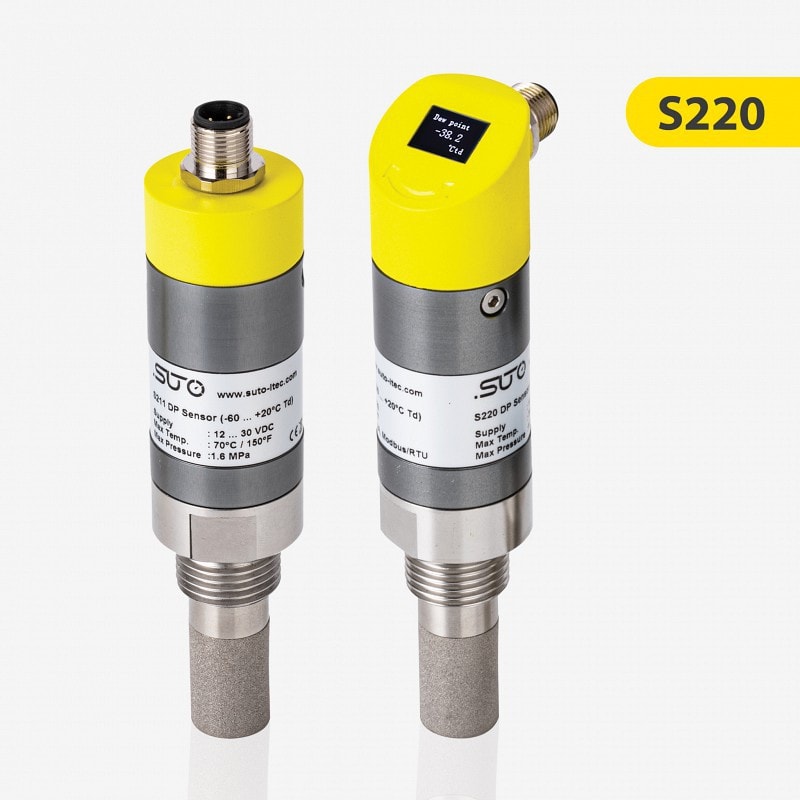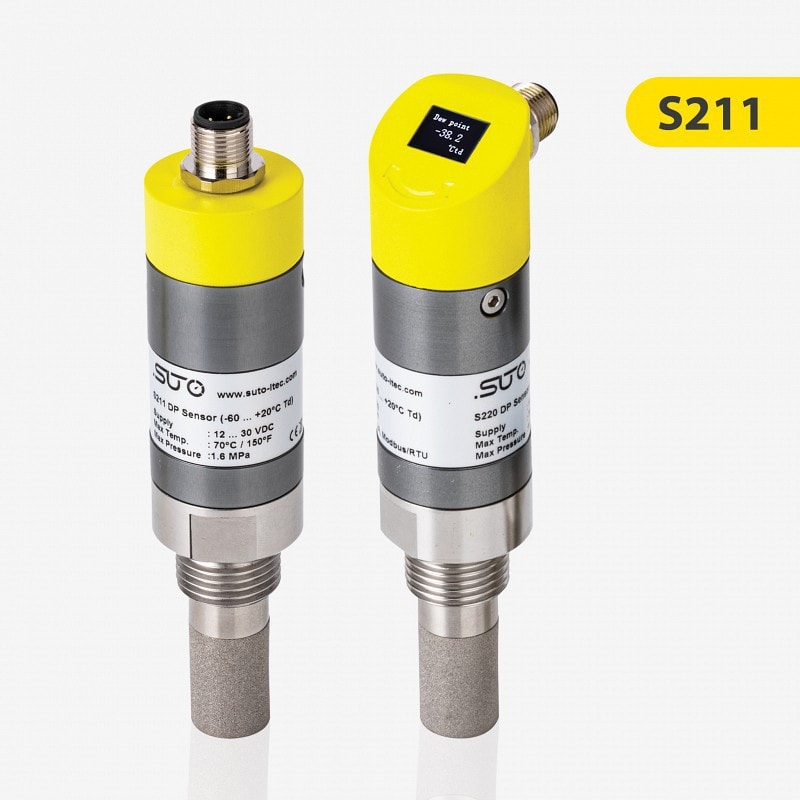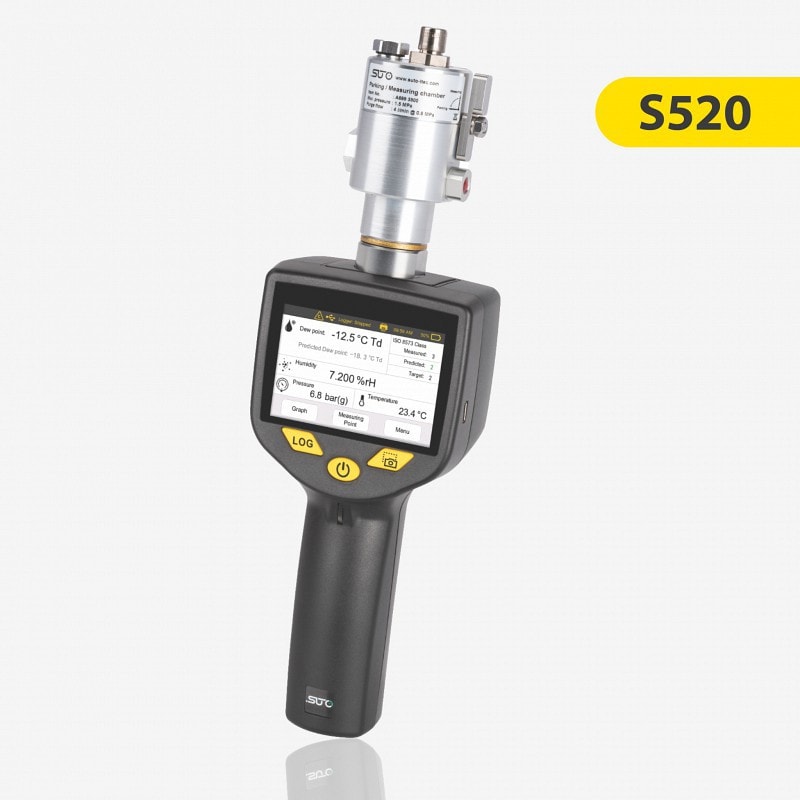DEW POINT METERS FOR COMPRESSED AIR AND GASES
A dew point meter for compressed air and compressed gases is used to ensure the compressed air quality which is used in the production and throughout all the processes in a factory. Not only protecting equipment and keeping the air quality at a certain level, but also for air quality audits according to ISO 8573-1 and ISO 8573-3 a dew point meter is absolutely necessary.
SUTO iTEC dew point meters and sensors are designed for high accuracy and reliability. They enable precise measurements of pressure dew point, humidity and temperature in compressed air and gases and ensure reliable monitoring and control of compressed air quality in industrial environments.
SUTO iTEC has more than 20 years of experience in developing high-precision dew point sensors for industrial applications.
Calculate your Dew Point
Our humidity calculator offers a simple solution to calculate measurement-related parameters in terms of humidity, dew point, and more.
DEW POINT MEASUREMENT AND MONITORING
Have you ever had a dryer fail in your compressed air system and ruin your production output? But you didn’t notice it until it was too late?
Dry compressed air is one of the most important quality parameters when it comes to process safety. When ambient air is compressed, the humidity in the air volume increases dramatically, making the air susceptible to condensation in the form of water droplets. What can be worse than having water droplets in the compressed air piping that can cause machine downtime, contamination of your process, or even blockages?
The use of a dew point measuring instrument, called a dew point analyzer or dew point meter for compressed air and gases, will help the user to operate a safe and reliable compressed air system by providing early warning alarms, not when things have already gotten worse.
The following section provides an overview of the most important information regarding dew point measurement in compressed air and gas systems.
What is the dew point temperature?
The dew point is the temperature at which water vapor in the air begins to condense. Typically, the dew point temperature under ambient pressure and temperature conditions is around 12 to 14 °C Td.
Everyone has experienced this phenomenon in their daily lives. Take a cold drink from the refrigerator on a warm summer day, and within seconds, water droplets will start to form on the surface of the drink. The reason is that the cold drink has caused the surrounding air to condense its water vapor on the surface of the beverage; the dew point temperature has been reached.
It is most common to refer to the temperature described above as the dew point, pressure dew point, or dew point temperature. However, at temperatures below 0 °C Td, the correct term would be frost point instead of dew point. For the past 20 years, the terms’ dew point and dew point meter have been used and accepted, where frost point sensor or frost point meter would be the correct term but is not commonly used in the industry.
In which applications are compressed air dew point meters typically used for monitoring?
Dew point sensors are used in applications where it is critical to monitor and maintain dry process air. Dew point meters are used to collect the stored measurement data, respond to the measured humidity values, and trigger alarms or actuators when limit values are reached.
- In a modern paint shop system, spray guns are typically powered by compressed air. If water condensate were to mix with the paint, it would easily lead to water contamination on the paint surface. This can destroy the paint shop’s output for an entire day’s production.
- In the food industry, compressed air is often used to inflate packaging containers; liquid water should never get into the process because, firstly, water is an easy carrier of bacteria, and secondly, who likes to open a bag of crispy potato chips that are all squishy?
-
Dew point meters are used to monitor the compressed air quality in general manufacturing processes to ensure product quality and equipment performance
-
Monitoring compressed air quality in pharmaceutical manufacturing to meet regulatory standards and ensure product purity.
- Monitoring compressed air quality in electronics manufacturing is necessary to prevent damage to sensitive components and ensure product reliability.
-
Monitoring compressed air quality in packaging processes to prevent contamination and ensure product hygiene.
Dew point sensors for compressed air are part of any process where a single drop of water could ruin the entire production output or damage machinery and other installed air consumers.
Which measuring ranges can a dew point sensor cover?
SUTO dew point transmitters for compressed air and gases are based on two sensor principles. Polymer sensors for dew points between -60 … +50 °C Td and QCM sensors for a range of -100 … -20 °C Td. By combining both principles in a single unit, SUTO sensors can accurately measure the full range of -100 … +20 °C Td.
SUTO offers a wide range of dew point meters, dew point monitors, and OEM solutions to cover the range required by our customers. Even in high-pressure applications, up to 350 bar SUTO dew point instruments can be used.
Our service and sales team is at your disposal to find the most suitable dew point meter for compressed air and gases for your application and needs.
What gases can be measured with SUTO Dew Point Meters?
While the primary application of SUTO dew point sensors is in compressed air systems, they can also be used in other pressurized gases such as CO2, oxygen or nitrogen.
If you intend to use the dew point meter to measure humidity, temperature and dew point in alternative gases, please contact our service team. We are committed to finding the optimum solution to meet your needs.
What makes SUTO dew point meters different from others?
SUTO has more than 20 years of experience in the development of dew point sensors for use in compressed air systems and compressed gases. During this time, the engineers have continuously developed new measurement methods and even developed their own sensor elements for our innovative dew point meters.
The latest innovation is the dual sensor module, which combines two different measurement principles in a single unit, using a QCM sensor for low humidity measurement and a polymer sensor for standard humidity. A polymer sensor is typically used in dew point transmitters to measure the humidity of pressurized air. Polymer sensors offer reliable measurement results coupled with fast response times and long-term stability. These types of instruments are typically used in refrigerator dryers where dew points of +3°C Td are expected.
In high-tech applications, where dew points of -60 to -100 °C Td are common, polymer sensors are unlikely to give accurate readings. However, many manufacturers offer polymer sensors for the full range of -100 … +20 °C Td, which are not suitable for accurate measurement.
Do Dew point meters need calibration, inspection and service?
Like any other measuring instrument, a dew point meter used for monitoring should be calibrated regularly. When a new dew point meter is delivered, it’s calibrated by the SUTO service team. This ensures that the measurement data is reliable and that the values are within the tolerance. In the field, contamination, such as dust or other impurities, can lead to inaccuracy of the measuring instruments. Therefore, it is recommended to calibrate the instruments at regular intervals. Our service team will calibrate the sensor and inspect the sensor surface to ensure that the temperature, humidity, and dew point are measured correctly and accurately.
Learn more about our calibration service.
Accessories to be used with dew point sensors
SUTO offers a wide range of useful accessories to complete the full range of dew point measurement and monitoring. Typically, measurement chambers are most commonly used in compressed air systems. When using a dew point meter or sensor, it’s important that the air or gas flow passes the surface of the sensor element.
This is critical for accurate measurement and fast response times. For installations where it is not possible to install the sensor tip directly in the air flow, SUTO offers various measuring chambers as accessories. Chambers with quick connectors for quick and easy installation under pressure, or bypass chambers for loss-free measurements, as well as high-pressure measuring chambers and many more. Ask our service team for their expertise.
Calculate Your Dew Point
- Our humidity calculator offers a simple solution to calculate measurement-related parameters in terms of humidity, dew point, and more.








